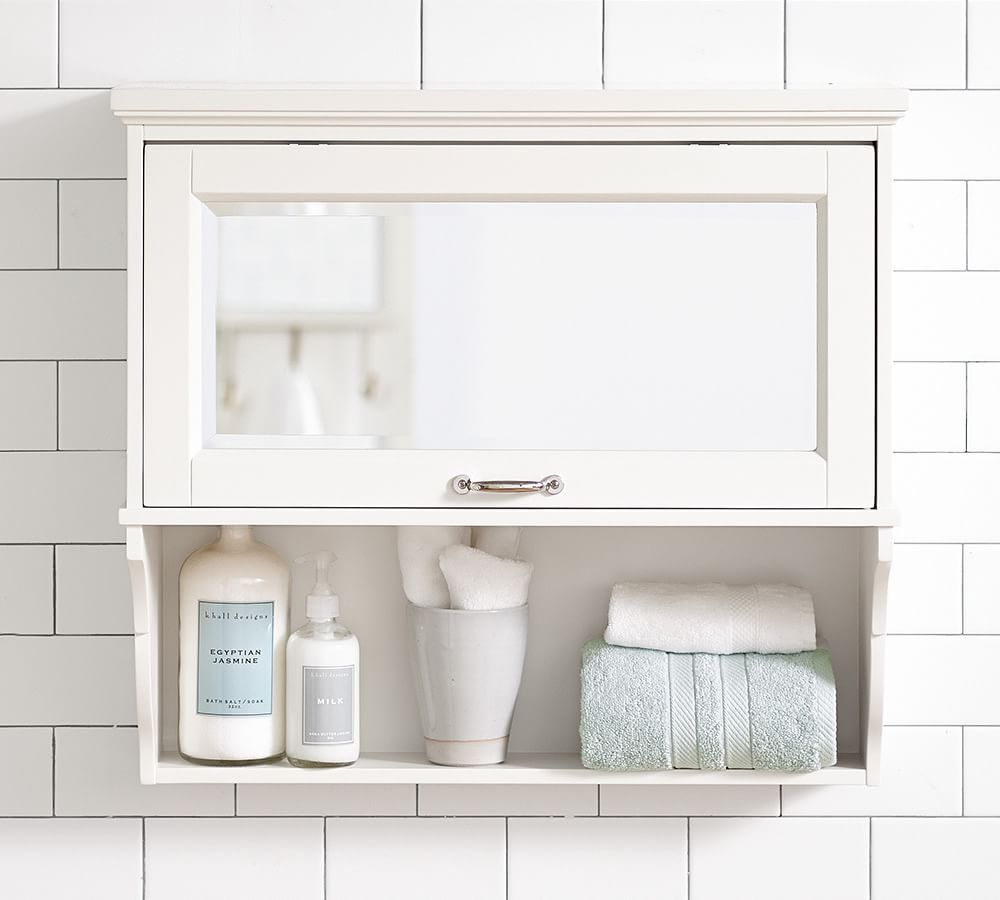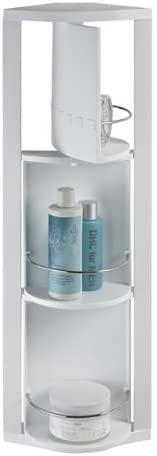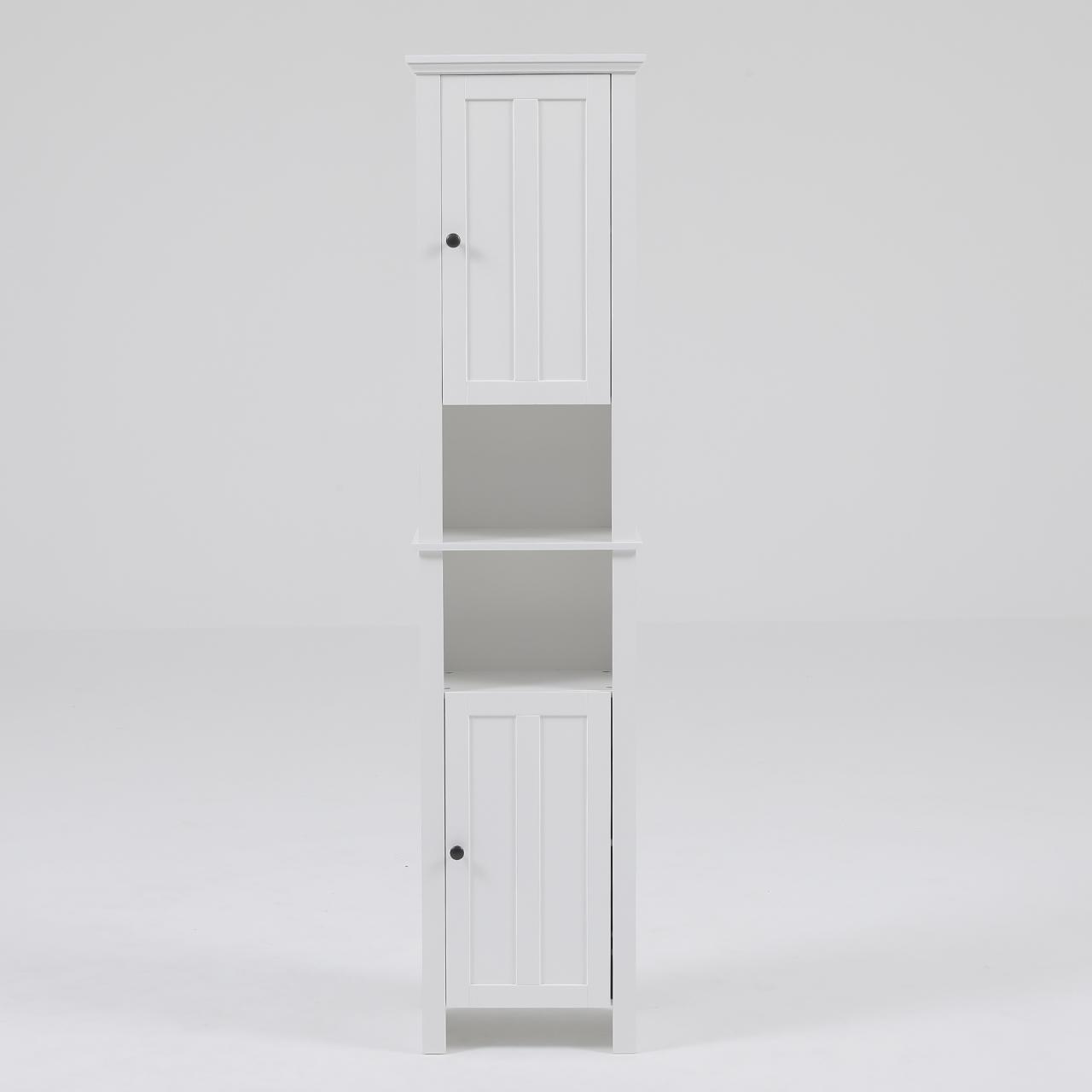Maximizing Space with Small Narrow Bathroom Cabinets
Small bathrooms can be tricky to navigate when it comes to storage. However, I’ve found that with the right approach, even the tiniest space can be transformed into an organized and efficient area. Small narrow bathroom cabinets are perfect for those tight spots where you need just a little extra storage without overwhelming the room. Here’s how you can make the most out of these compact cabinets to maximize your bathroom space.
- Strategic Placement One of the first things I realized when working with a small bathroom is that placement is everything. Narrow cabinets can be tucked into corners, squeezed between the sink and shower, or even mounted on the wall. By utilizing vertical space, I was able to keep the floor area clear, which made the room feel more open. A narrow cabinet that was only six inches wide fit perfectly between my sink and shower, proving that even the smallest spaces can be used effectively.
- Utilizing Vertical Space Another key tip is to think vertically. Instead of spreading storage horizontally, which eats up precious floor space, I found it more effective to go up. Tall, narrow cabinets can store a surprising amount of items without taking up much room. I once added a floor-to-ceiling cabinet in a tiny bathroom, and it provided ample storage for towels, toiletries, and cleaning supplies, all without crowding the room.
- Customizing Storage Inside the Cabinet Small narrow cabinets may have limited exterior space, but the interior can be customized to suit your needs. I’ve used adjustable shelves, hooks, and even pull-out drawers to maximize the storage capacity inside the cabinet. By organizing the space efficiently, I was able to fit more items than I initially thought possible, keeping my bathroom clutter-free.
- Incorporating Mirrored Surfaces A trick I’ve often used to make small spaces feel larger is incorporating mirrors. Mirrored cabinets not only provide storage but also reflect light and create the illusion of a larger room. I installed a narrow mirrored cabinet above my sink, and it instantly brightened up the bathroom while offering additional storage for everyday items.
- Keeping Essentials Accessible While maximizing space is important, accessibility shouldn’t be sacrificed. I’ve found that placing frequently used items in easily reachable areas within the cabinet is crucial. I keep everyday essentials like toothpaste, soap, and skincare products at eye level or within the top shelves, so I don’t have to rummage around to find what I need.
- Using Door Space Efficiently Don’t forget about the inside of the cabinet doors! I’ve attached small hooks, magnetic strips, or even a slim rack to the inside of my cabinet doors to hold items like hair tools, toothbrushes, or even small cleaning supplies. This often-overlooked space can add a surprising amount of storage.

Choosing the Right Design for Your Compact Bathroom
Selecting the perfect cabinet design for a compact bathroom can be daunting, especially when you’re working with limited space. Over the years, I’ve discovered that the right design doesn’t just complement your bathroom’s aesthetic; it also enhances functionality. Narrow cabinets are particularly great because they offer storage without overwhelming the space. Here’s what I consider when choosing the ideal design for a small bathroom.
- Understanding Your Space The first step I always take is to assess the space available. Measuring the area ensures that I pick a cabinet that fits perfectly without causing any inconvenience. I also look at the room’s layout to identify the best spots for storage. A narrow cabinet that’s too wide or deep can make the room feel cramped, so I make sure to consider all dimensions before making a decision.
- Choosing a Style That Complement the Bathroom When it comes to style, I’ve found that it’s important to choose a design that complements the overall aesthetic of the bathroom. For a modern bathroom, I lean towards sleek, minimalist cabinets with clean lines and neutral colors. In a more traditional space, I might opt for a narrow cabinet with detailed woodwork or a classic finish. The key is to select a cabinet that enhances the room’s design without making it feel cluttered.
- Opting for a Space-Saving Design Space-saving features are a must in compact bathrooms. I look for cabinets that offer clever storage solutions, like built-in shelves, pull-out trays, or compartments designed for specific items. Floating cabinets are also a favorite of mine because they free up floor space and make the room feel larger. These designs help me keep everything organized without taking up too much room.
- Considering the Functionality of the Cabinet Functionality is just as important as style. I always consider how I’ll use the cabinet daily—whether I need it for storing toiletries, towels, or cleaning supplies. Some designs offer more flexibility than others, with adjustable shelves or customizable compartments that allow me to tailor the storage to my needs. A cabinet that looks good but doesn’t meet my storage requirements is ultimately not the right choice.
- Incorporating Mirrored Cabinets for Added Utility I’m a big fan of mirrored cabinets in small bathrooms. Not only do they serve as storage, but they also double as a mirror, saving space and adding functionality. The reflective surface can also make the room appear larger and brighter, which is a huge plus in a compact space. I often place a mirrored cabinet above the sink or vanity to maximize its utility.
- Choosing a Finish That Stands Up to Moisture Bathrooms are prone to humidity, so I always choose a cabinet finish that can withstand moisture. I’ve learned the hard way that not all materials hold up well in a bathroom environment. Water-resistant finishes, such as laminate, acrylic, or specially treated wood, ensure that the cabinet stays in good condition over time. This consideration is crucial for maintaining both the appearance and durability of the cabinet.

Material Options for Durable and Stylish Cabinets
When selecting a narrow bathroom cabinet, the material is a critical factor that affects both durability and style. Over the years, I’ve explored various materials to find those that not only withstand the moist environment of a bathroom but also add to its aesthetic appeal. Here’s a breakdown of the best material options I’ve found for durable and stylish bathroom cabinets.
- Solid Wood for a Timeless Look Solid wood is a classic choice that adds warmth and elegance to any bathroom. I’ve always appreciated the natural beauty and durability of wood, especially when it’s treated to resist moisture. Hardwoods like oak, maple, and walnut are particularly good choices. Although solid wood can be more expensive, I’ve found that its longevity and timeless appeal make it a worthwhile investment, especially in a bathroom where quality materials matter.
- Engineered Wood for Cost-Effective Durability If you’re looking for a more affordable option that still offers durability, engineered wood is a great alternative. Made from layers of wood bonded together, it’s more resistant to warping and moisture than solid wood. I’ve used engineered wood cabinets in several bathrooms, and they’ve held up well over time, especially when finished with a moisture-resistant coating. Plus, they often come in a variety of finishes that mimic the look of real wood.
- Laminate for Versatility and Easy Maintenance Laminate is another material I often recommend, especially for those who want a wide range of styles and colors. It’s made by bonding layers of paper or fabric to particleboard or MDF, creating a durable and easy-to-clean surface. I appreciate laminate for its versatility—it can mimic the appearance of wood, stone, or even metal. It’s also highly resistant to stains and scratches, making it a practical choice for a bathroom cabinet that sees daily use.
- Metal for a Modern, Industrial Feel For those who prefer a modern or industrial aesthetic, metal cabinets are a fantastic option. Stainless steel, aluminum, and other metals are incredibly durable and resistant to moisture, making them ideal for a bathroom environment. I’ve found that metal cabinets not only offer a sleek, contemporary look but also require minimal maintenance. They’re easy to clean and resistant to rust when properly treated, ensuring they stay looking great for years.
- Glass for an Elegant, Open Look Glass-front cabinets or cabinets with glass accents can add a touch of elegance to a bathroom. I’ve used glass in bathroom cabinets to create an open, airy feel, especially in small spaces where I want to avoid a heavy, closed-off look. Tempered glass is the best choice for bathroom use since it’s stronger and safer than regular glass. Paired with a metal or wood frame, glass can create a beautiful, modern cabinet that’s both stylish and functional.
- Acrylic for a Sleek, Contemporary Design Acrylic is a material I’ve come to appreciate for its sleek, modern look and durability. It’s lightweight, resistant to moisture, and comes in a variety of colors and finishes. I’ve used acrylic cabinets in bathrooms where I wanted a clean, contemporary design without worrying about maintenance. Acrylic is also easy to clean and doesn’t show water spots or fingerprints as easily as some other materials.

Innovative Storage Solutions in Narrow Bathroom Cabinets
When it comes to small bathrooms, every bit of storage counts. Narrow bathroom cabinets are a fantastic solution, but to truly maximize their potential, I’ve found that incorporating innovative storage solutions is key. These clever designs and features can make even the smallest cabinet a powerhouse of organization. Here are some of the most effective storage solutions I’ve discovered for narrow bathroom cabinets.
- Pull-Out Shelves for Easy Access One of my favorite features in a narrow cabinet is the pull-out shelf. Instead of reaching into the back of a deep cabinet, a pull-out shelf allows me to easily access everything stored inside. This is particularly useful in a tall, narrow cabinet where items might get lost in the depths. By installing pull-out shelves, I’ve made it much easier to keep things organized and within reach.
- Built-In Drawers for Small Items Another great solution I’ve found is incorporating built-in drawers into the cabinet design. Drawers are perfect for storing small items like makeup, toiletries, and other bathroom essentials. I prefer narrow, stacked drawers that fit neatly within the cabinet, keeping everything organized and easily accessible. This setup prevents the cabinet from becoming cluttered and makes it easier to find what I need quickly.
- Adjustable Shelves for Customized Storage Adjustable shelves are a must-have in any bathroom cabinet, especially narrow ones. I’ve found that the ability to move shelves up or down depending on the height of the items I’m storing is invaluable. This customization allows me to maximize the space inside the cabinet, whether I’m storing tall bottles or stacking smaller items. It’s a simple solution that makes a big difference in how much a cabinet can hold.
- Over-the-Door Storage for Extra Space The inside of the cabinet door is often an overlooked storage area, but I’ve learned to make the most of it. Over-the-door storage solutions, like hooks, small baskets, or even a slim rack, can add extra space for items like hair tools, cleaning supplies, or toiletries. This extra storage doesn’t take up any additional room inside the cabinet, making it an efficient way to keep things organized.
- Integrated Lighting for Better Visibility One of the challenges I’ve faced with narrow cabinets is that they can sometimes be dark and hard to see, especially if they’re tall. To solve this, I’ve started incorporating integrated lighting into my cabinets. LED strips or small puck lights inside the cabinet make it much easier to see and access items, especially in the early morning or late at night. This added visibility enhances the cabinet’s functionality and makes daily routines more convenient.
- Hidden Compartments for Discreet Storage I love using hidden compartments in my narrow bathroom cabinets for storing items that I don’t need to access frequently. These compartments are perfect for keeping valuables, backup supplies, or less frequently used items out of sight but still easily accessible when needed. By incorporating hidden storage, I’ve been able to keep the main areas of the cabinet clear for daily essentials while still having a place for everything else.
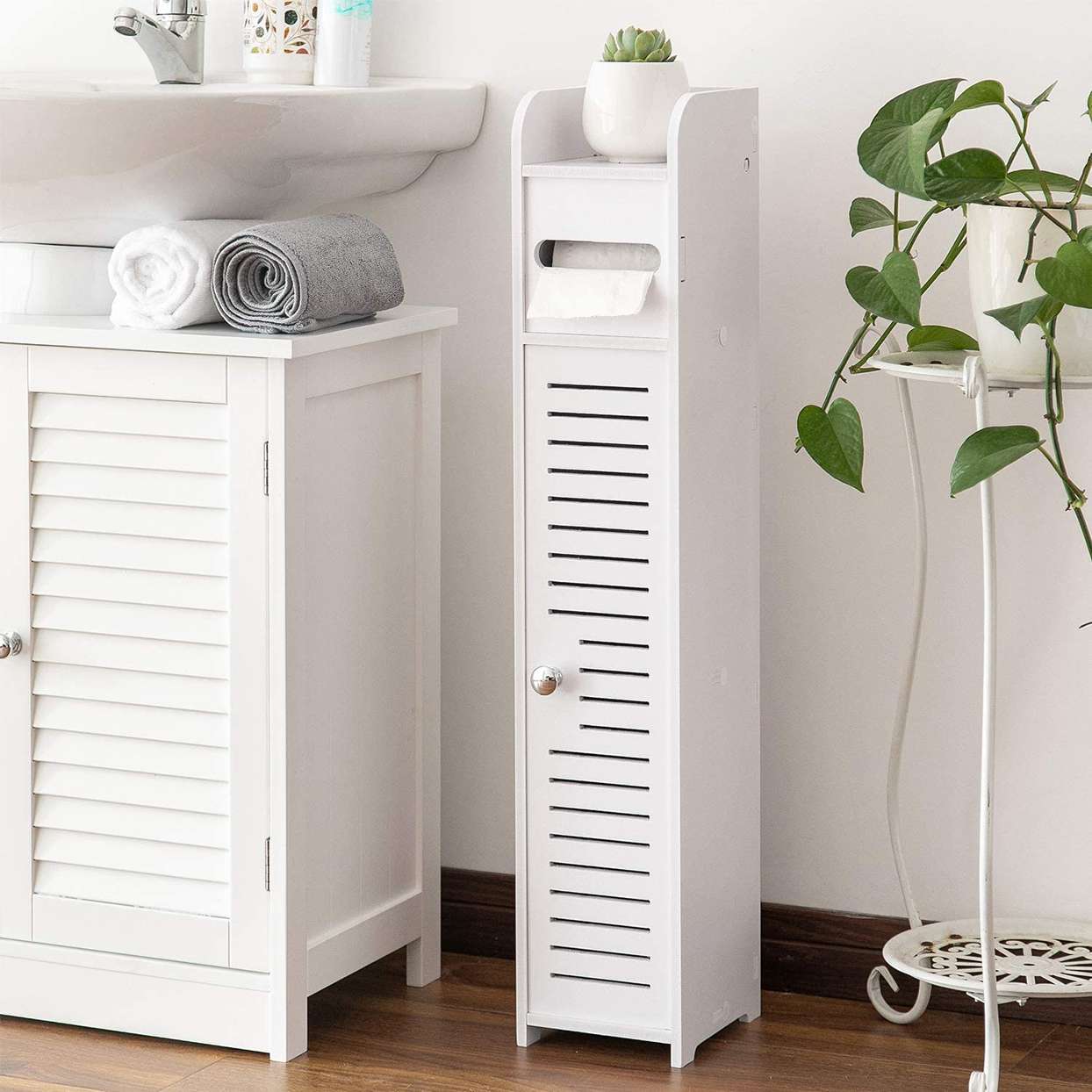
Installation Tips for Small Narrow Cabinets in Tight Spaces
Installing a small narrow cabinet in a tight bathroom space can be a daunting task, but with the right approach, it’s entirely doable. I’ve installed several narrow cabinets in various bathrooms over the years, and each time, I’ve learned new tricks to make the process smoother. Here are some of my best tips for installing these cabinets in challenging spaces.
- Careful Measurement and Planning The first and most crucial step is to measure carefully. I always measure the space multiple times to ensure accuracy. It’s important to account for the width, height, and depth of the cabinet, as well as the space needed to open doors or drawers. I also consider any plumbing or electrical fixtures that might be in the way. Proper planning ensures that the cabinet will fit perfectly without any surprises during installation.
- Choosing the Right Hardware The hardware you choose can make a big difference in how easy the cabinet is to install and use. I opt for sturdy brackets, hinges, and screws that can support the weight of the cabinet, especially if it’s going to hold heavy items. For wall-mounted cabinets, I use heavy-duty anchors that can securely attach the cabinet to the wall. Choosing the right hardware ensures that the cabinet is safe and functional once installed.
- Making Use of a Level I’ve learned the hard way that installing a cabinet without a level can lead to frustrating results. A level ensures that the cabinet is straight, which is crucial not only for aesthetics but also for functionality. If a cabinet is even slightly off, it can cause doors and drawers to not close properly. I always check and double-check with a level before finalizing the installation.
- Pre-Drilling Holes for Easier Installation Pre-drilling holes before inserting screws is a small step that makes a big difference. I’ve found that pre-drilling helps to prevent the wood from splitting and makes it easier to align screws. This is especially important when installing in tight spaces where maneuverability is limited. By pre-drilling, I can ensure a smoother, quicker installation process.
- Securing the Cabinet to Studs When installing a wall-mounted cabinet, I always try to secure it to the studs in the wall for maximum stability. If the cabinet isn’t aligned with the studs, I use wall anchors that can handle the weight. This is particularly important in a bathroom where the cabinet might be holding heavy or valuable items. Ensuring that the cabinet is securely attached to the wall gives me peace of mind that it will stay in place over time.
- Finishing Touches for a Polished Look After the cabinet is installed, I take the time to add any finishing touches that will enhance its appearance and functionality. This might include adding trim to cover gaps, sealing around the edges to prevent moisture from getting in, or adjusting the doors and drawers to ensure they open and close smoothly. These final steps help to create a polished, professional look that makes the cabinet feel like a seamless part of the bathroom.
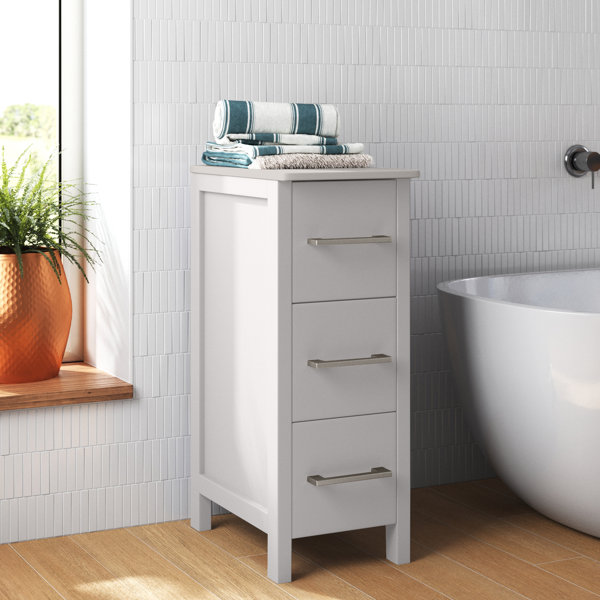
Maintaining and Cleaning Your Bathroom Cabinet
Once you’ve installed a beautiful new bathroom cabinet, keeping it in top condition is essential for maintaining both its appearance and functionality. I’ve found that regular maintenance and cleaning are key to ensuring that the cabinet remains in good shape, especially in the moist environment of a bathroom. Here’s how I keep my bathroom cabinets looking and working like new.
- Regular Dusting and Wiping Dust can accumulate on the surface of the cabinet, especially on the top where it’s less noticeable. I make it a habit to dust the cabinet regularly with a soft cloth to prevent buildup. For a more thorough clean, I wipe down the surfaces with a damp cloth and a mild cleaner. This helps to remove any grime, fingerprints, or soap scum that might accumulate over time. Keeping the cabinet clean not only makes it look better but also prevents the materials from deteriorating.
- Cleaning Handles and Hardware The handles and hardware on a cabinet are often touched multiple times a day, which can lead to the buildup of oils and dirt. I clean these areas regularly with a gentle cleaner to prevent tarnishing or corrosion. If the hardware is removable, I sometimes take it off to give it a more thorough cleaning. This helps to keep the cabinet looking polished and ensures that the hardware functions smoothly.
- Addressing Moisture and Humidity Bathrooms are prone to moisture and humidity, which can be tough on cabinets. I’ve learned to manage this by ensuring good ventilation in the bathroom, either by using an exhaust fan or opening a window. If I notice any signs of moisture damage, like warping or discoloration, I address it immediately to prevent further issues. In some cases, I apply a protective finish to the cabinet to help it resist moisture better.
- Checking for Wear and Tear Over time, cabinets can show signs of wear and tear, especially in high-traffic bathrooms. I regularly check for any issues like loose hinges, scratches, or worn finishes. If I find any problems, I address them right away, whether it’s tightening screws, touching up paint, or replacing worn-out parts. Taking care of these small issues prevents them from becoming bigger problems down the road.
- Protecting Against Stains and Spills Stains and spills are inevitable in a bathroom, but I’ve found that quick action can prevent permanent damage. If I spill something on the cabinet, I clean it up immediately to avoid stains. I also use coasters or trays to protect the surface from water rings or product spills. By taking these precautions, I keep the cabinet looking fresh and prevent any long-term damage.
- Polishing for a Lasting Shine To keep the cabinet looking its best, I occasionally polish it with a product appropriate for the material. For wood cabinets, I use a wood polish that nourishes the wood and enhances its shine. For laminate or acrylic, I use a cleaner that leaves a streak-free finish. Polishing not only improves the cabinet’s appearance but also adds a layer of protection that can extend its life.
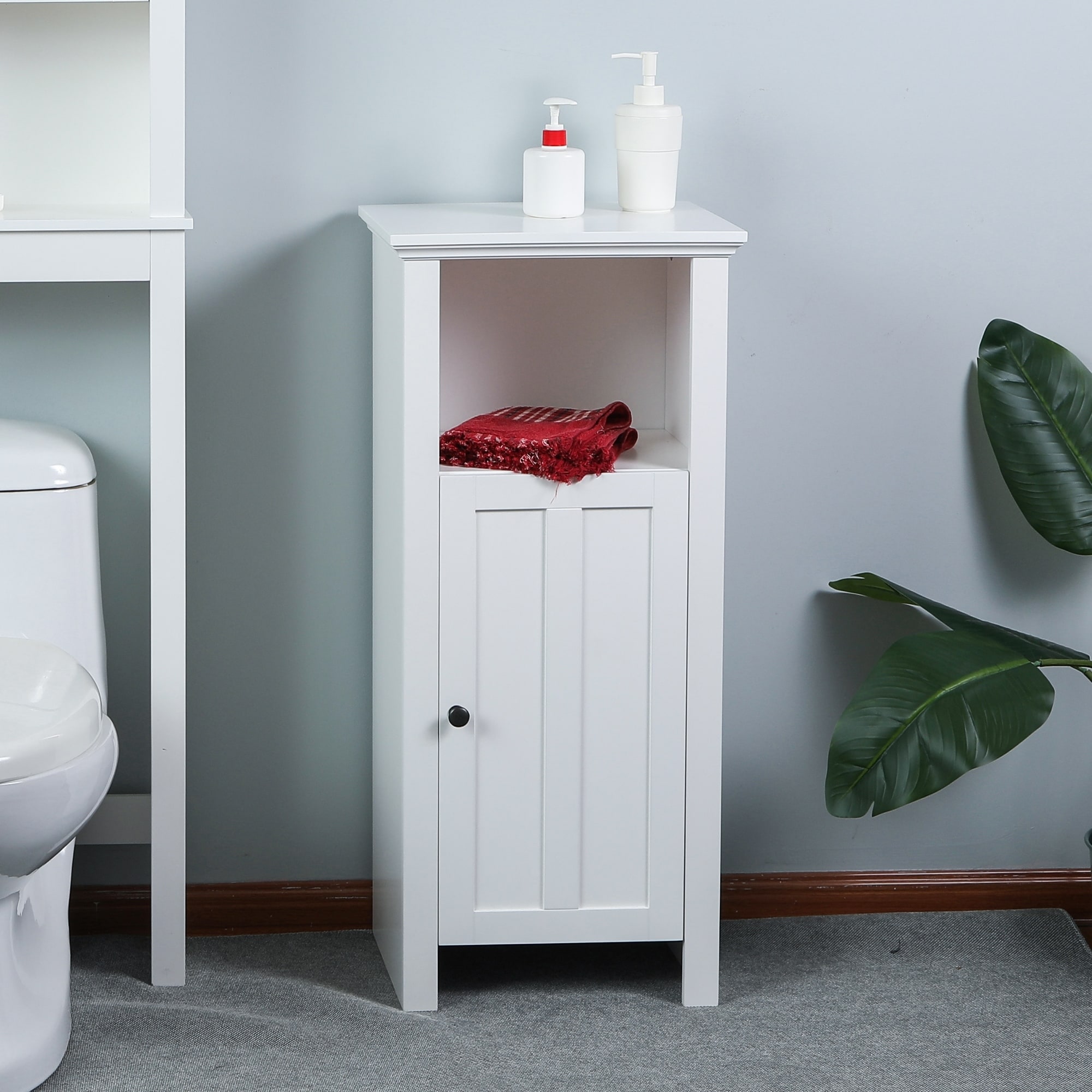
Budget-Friendly Small Narrow Bathroom Cabinet Ideas
Creating a functional and stylish bathroom doesn’t have to break the bank. Over the years, I’ve discovered that with a little creativity and smart shopping, it’s possible to find budget-friendly small narrow bathroom cabinets that offer both form and function. Here are some ideas I’ve used to add storage to my bathroom without spending a fortune.
- Repurposing Furniture One of the best ways I’ve saved money on bathroom storage is by repurposing existing furniture. A narrow bookshelf, a small dresser, or even a vintage cabinet can be transformed into a bathroom storage solution with a little imagination. I’ve painted, stained, or added new hardware to old pieces to give them a fresh look that fits my bathroom’s aesthetic. This approach not only saves money but also adds a unique, personal touch to the space.
- DIY Cabinet Projects If you’re handy with tools, building your narrow bathroom cabinet can be a fun and cost-effective project. I’ve built simple cabinets using affordable materials like plywood or MDF, which are both budget-friendly and easy to work with. There are plenty of tutorials and plans available online, so even if you’re not an expert woodworker, you can still create a functional cabinet that fits your space perfectly.
- Shopping Secondhand Thrift stores, garage sales, and online marketplaces are great places to find affordable bathroom cabinets. I’ve found some fantastic pieces at a fraction of the cost of new furniture. With a little TLC, these secondhand finds can be restored to their former glory. Whether it’s a coat of paint, new hardware, or just a good cleaning, I’ve transformed many inexpensive finds into stylish bathroom storage.
- Flat-Pack Furniture Flat-pack furniture is another budget-friendly option that I’ve used in my bathrooms. These pieces are often more affordable because they come unassembled, which means you’ll need to put them together yourself. However, the savings can be significant, and many flat-pack options are designed with small spaces in mind. I’ve found that with a little patience and some basic tools, it’s easy to assemble these cabinets and create a customized storage solution.
- Using Baskets and Bins for Extra Storage Sometimes, all you need are a few baskets or bins to add storage to a narrow bathroom cabinet. I’ve used inexpensive storage bins to organize toiletries, towels, and cleaning supplies inside my cabinets. Baskets can be particularly useful for storing smaller items that might otherwise get lost in a deep cabinet. This simple solution helps to keep everything organized and easily accessible without the need for expensive upgrades.
- Customizing Inexpensive Cabinets Even if you purchase a basic, inexpensive cabinet, there are plenty of ways to customize it to better fit your space and style. I’ve added new hardware, painted or stained the wood, or added decorative trim to make a basic cabinet look more high-end. These small upgrades can make a big difference in the overall look of the bathroom while keeping costs low.

Common Mistakes to Avoid
As I’ve worked on bathroom renovations over the years, I’ve encountered several common mistakes that can make selecting and installing a narrow bathroom cabinet more challenging than it needs to be. Here are some pitfalls to watch out for and how to avoid them.
One mistake I’ve seen is failing to measure the space accurately before purchasing a cabinet. It’s crucial to measure not just the space where the cabinet will go but also the surrounding area to ensure there’s enough room to open doors or drawers without obstruction. I always double-check my measurements to avoid any surprises.
Another common mistake is overlooking the importance of moisture resistance. Bathrooms are humid environments, and using a cabinet that isn’t designed to withstand moisture can lead to warping, discoloration, and even mold. I always choose materials and finishes that are water-resistant and suitable for a bathroom environment.
Choosing style over functionality is another pitfall I’ve encountered. While it’s important for a cabinet to look good, it’s equally important that it meets my storage needs. I’ve learned to balance aesthetics with practicality, selecting cabinets that offer the right combination of style and storage.
Ignoring the need for proper installation is a mistake that can lead to serious issues down the line. I’ve seen cabinets installed without the proper support or hardware, leading to instability and even damage. Taking the time to secure the cabinet properly, especially in a bathroom where it may hold heavy items, is essential.
Finally, not considering long-term maintenance can be a costly oversight. Some materials and finishes require more upkeep than others, and choosing a cabinet that’s difficult to maintain can lead to frustration over time. I always consider how much time and effort I’m willing to invest in maintaining the cabinet and choose accordingly.
Avoiding these common mistakes has helped me successfully select, install, and maintain narrow bathroom cabinets that are both functional and stylish. By being mindful of these potential pitfalls, I’ve been able to create bathroom spaces that work well and look great.

Maximizing storage in a small bathroom involves choosing a narrow cabinet with innovative storage solutions like pull-out shelves, built-in drawers, and adjustable shelving. Incorporating over-the-door storage and using baskets or bins inside the cabinet can also help to keep items organized and easily accessible.
What materials are best for a bathroom cabinet?Materials like solid wood, engineered wood, laminate, and acrylic are all good choices for bathroom cabinets. These materials are durable and can withstand the moisture and humidity common in bathrooms. It’s important to choose materials that are treated or finished to resist water damage.
Can I install a narrow bathroom cabinet myself?Yes, installing a narrow bathroom cabinet yourself is possible with the right tools and preparation. Careful measurement, proper hardware, and securing the cabinet to studs are key steps in ensuring a successful installation. If you’re not comfortable with DIY projects, hiring a professional might be a good option.
How do I maintain and clean a bathroom cabinet?Regular dusting, wiping down surfaces with a mild cleaner, and cleaning handles and hardware are important for maintaining a bathroom cabinet. Managing moisture, checking for wear and tear, and occasionally polishing the cabinet can also help to keep it in good condition.
Are there budget-friendly options for narrow bathroom cabinets?There are many budget-friendly options for narrow bathroom cabinets, including repurposing furniture, DIY projects, shopping secondhand, and using flat-pack furniture. Customizing inexpensive cabinets with paint, new hardware, or decorative trim can also give them a more high-end look without a high-end price.
What are some common mistakes to avoid when choosing a bathroom cabinet?Common mistakes include failing to measure the space accurately, choosing style over functionality, overlooking the importance of moisture resistance, neglecting proper installation, and not considering long-term maintenance. Avoiding these pitfalls can help ensure that you choose a cabinet that works well in your space and lasts for years.
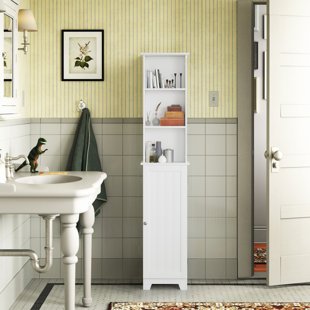
Stunning Bedroom Storage Ideas Slim bathroom storage

Small bathroom storage, Bathroom storage cabinet

Woodyhome Wooden Bathroom Floor Cabinet Free Standing Bathroom
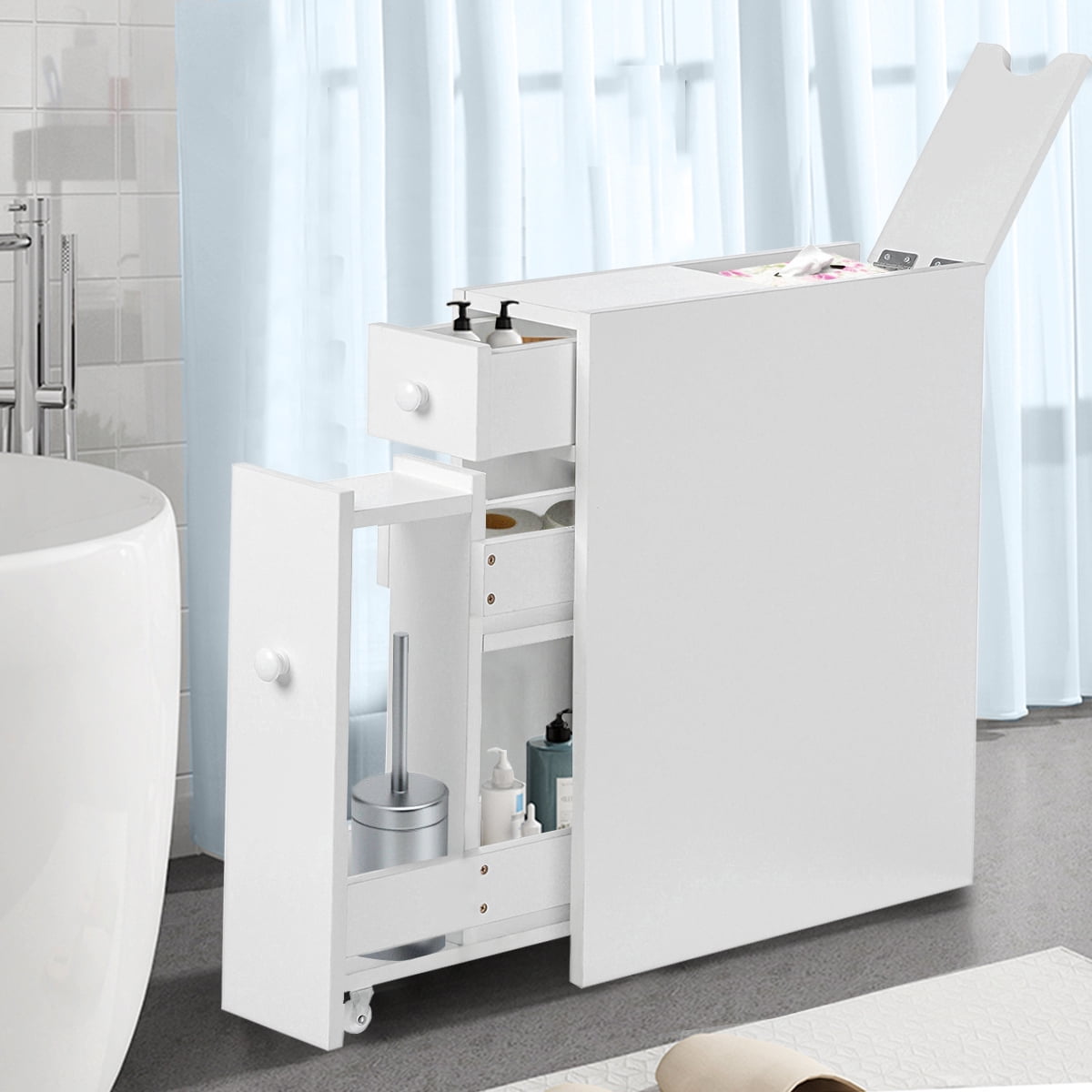 Related articles:
Related articles:
- Floor Mounted Bathroom Cabinet
- Should Bathroom Cabinets Match Kitchen Cabinets
- Modern Wood Bathroom Cabinets
- Roper Rhodes Summit Bathroom Cabinet
- Kraftmaid Bathroom Cabinets Online
- Bathroom Cabinet Measurements
- Wooden Bathroom Cabinets White
- Hemnes Bathroom Cabinet Review
- How To Replace A Bathroom Cabinet
- L Shaped Bathroom Cabinets
